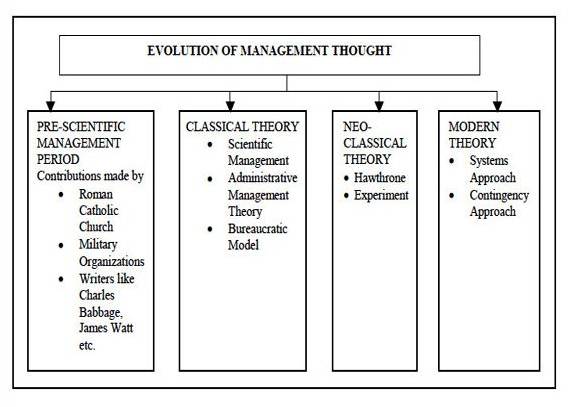The article gives a quick glimpse along with examples of Evolution and Functions of Management.
Every organizational, social, and economic activity involves management. Management exists wherever there is human activity. In the structured group activity that is human economic life, management plays a crucial role. For a corporate concern, a central directing and controlling agency is essential. Material, labor, money, and other productive resources are committed to the management’s organizational prowess, administrative acumen, and adventurous initiative. In this way, management gives a company enterprise leadership. The resources of production stay just that—resources—and never transform into output in the absence of capable managers and strong management leadership. In today’s environment, management is so vital that it has a significant impact on both the nation’s future and the welfare of its citizens.
Evolution and Functions of Management
Evolution of Management:
When humans first began to live in communities, management first emerged. Strong individuals divided the populace into groups based on their physical, mental, and intellectual prowess, as history demonstrates. The Roman Catholic Church, the armed forces, and the organization of public life in ancient Greece all provide examples of how the widely accepted management concepts have been used. Thus, since the beginning of civilization, management has been practiced in diverse forms around the world. But the role changed drastically with the start of the Industrial Revolution. Industry developed a very sophisticated structure.
Evolution of management thought may be divided into four stages:
- 1. Pre-scientific management period– In this system, the entrepreneur is given access to cash, hired labor, land, and structures, and he or she works to combine these resources to effectively accomplish a certain objective. The field of management changed as a result of all these developments.
- For example- Instead of getting it, workers went to work, and as a result, the industrial system as it exists today became a defining aspect of the economy. Employees of the organizations have to work strictly on a prescribed schedule and seems to know what the work they have to do in the industries. This theory mostly applied during industrial revolution in the 80s.
2. Classical Theory
The foundation of traditional management philosophy is the idea that employees only have financial and material requirements. It ignores social requirements and job happiness, in contrast to more recent ideas of workplace management. Rather, specialization of labor, centralized leadership and decision-making, and profit maximization are the tenets of traditional management philosophy.
- Scientific Management of Taylor– One of the most significant theories of traditional public administration is the Scientific Management Theory/approach, which was developed by Frederick Winslow Taylor. Taylor was an engineer by trade and approached everything and everything’s aspects with a scientific viewpoint. Because he worked in the production industry, he was concerned with improving worker efficiency in order to increase production in the shortest amount of time using the fewest resources. limit waste to the greatest extent possible and maximize earnings.
For example– A mall floor manager is very skilled since he makes use of every managerial function. He emphasizes the need of cultivating a cooperative attitude and mutual trust among the staff members. The staff members acknowledge that they learn a lot and can accomplish their goals while working under his direction. Their pay has increased as a result of this.
Read other topics of Management and Accounting in Tourism
- Administrative Management of Fayol– The bureaucratic model was proposed by German sociologist Max Weber.
(i) The hierarchy of authority
(ii) A labor division according to functional specialization.
(iii) A set of regulations.
(iv) The impersonality of social interactions.
(v) A set of operational guidelines.
(vi) Staff placement determined on technical proficiency.
(vi) Power and authority in law.
- Bureaucracy offers a strict organizational paradigm. Important human components are not taken into consideration.
1. Impersonality, rigidity, and increased control costs.
2. Anxiety brought on by the need to follow protocol and regulations.
3. Subordination to a superior.
4. A propensity to overlook the organization’s main objectives.
3. Neo-classical Theory or Behavior Approach
Classical theory serves as the foundation for neo-classical theory. It expanded, enhanced, and changed the traditional theory. While neoclassical theory placed more attention on interpersonal and social dynamics in the workplace, classical thought focused on the physical resources of the job and job content. The significance of psychology and sociology in comprehending individual and collective behavior within an organization was highlighted by the neo-classical theory.
4. Modern Theory or Systems Approach
The contemporary theory, which is the fourth main theory of management philosophy, is indicated by the systems approach to management. According to contemporary thinking, an organization is an adaptable system that must adapt to changes in its surroundings. These days, an organization is described as a formalized process where people work together to achieve goals.
Functions of Management
- Planning: Planning is the continuous process of making present entrepreneurial decisions systematically and with best possible knowledge of their futurity, organizing systematically the efforts needed to carry out these decisions and measuring the results of these decisions against the expectations through organized and systematic feedback.
- Organizing: Organizing requires a formal structure of authority and the direction and flow of such
authority through which work subdivisions are defined, arranged and coordinated so that each part relates to the other part in a united and coherent manner.
- Staffing: Staffing is the function of hiring and retaining a suitable work-force for the enterprise both at managerial as well as non-managerial levels. It involves the process of recruiting, training, developing, compensating and evaluating employees, and maintaining this workforce with proper incentives and motivations.
- Directing: The directing function is concerned with leadership, communication, motivation and
supervision so that the employees perform their activities in the most efficient manner possible, in order to achieve the desired goals.
- Controlling: The function of control consists of those activities that are undertaken to ensure
that the events do not deviate from the per-arranged plans.




